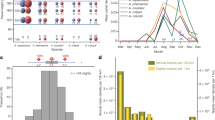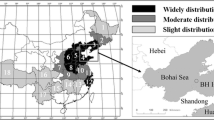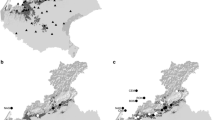Abstract
Comparisons of numbers of Heliothis armigera moths, caught in a light trap at ICRISAT Center (17°N 78°E), with wind direction has provided circumstantial evidence for windborne migration in India. The evidence is less convincing than that from northern Europe, possibly because flying populations are present around the trap throughout the year, although varying greatly in numbers between seasons. Comparisons were made for occasions when trap catch rose or fell over four successive nights with a correlation coefficient ≥ 0.9 and rate of catch change > 1 moth/night. Catch rises were used from only those parts of the lunar cycle when falls would be expected, and catch falls from those parts when rises would be expected. During the period May 1977 to December 1983 there were 23 rises and 16 falls. Rises occurred mostly during the seasons of maximum catch. All seven rises in February-April occurred with southeasterly winds, even though such winds blow on average only half the time in those months. These rises sometimes coincided with onset of southeasterlies; at other times there was a lag, consistent with flight from distant sources. Similar migrations seem possible in October-December, sometimes in the presence of cyclones over the Arabian Sea. The evidence for migration in August at ICRISAT, and in all seasons at ICRISAT Sub-Center, Hisar (29°N 76°E), is inconclusive.
Résumé
Des comparaisons effectuées sur un certain nombre de noctuelles Héliothis armigera, prises dans un piège lumineux au centre d’ICRISAT (17°N 78°E), en rapport avec la direction du vent ont fourni l’évidence indirecte d’une migration dans le sens du vent en Inde. Cette évidence est toutefois moins convaincante que celle d’Europe du Nord, peut-être en raison de la présence de populations volantes aux alentours du piège tout au long de l’année même si ce nombre varie fortement d’une saison à l’autre. Des comparaisons ont été effectuées lorsque les prises augmentaient ou diminuaient sur quatre nuits successives avec un coefficient de corrélation ≤0.9 et un taux de variation de prise > 1 papillon/nuit. Les augmentations de prises ont été utilisées seulement pour ces périodes du cycle lunaire durant lesquelles l’on s’attend à des chutes; et les diminutions de prises pour les périodes de cycle durant lesquelles l’on s’attend à des augmentations. Au cours de la période allant de mai 1977 à décembre 1983, il y a eu 23 augmentations et 16 diminutions. Les augmentations sont survenues principalement durant les saisons de prise maximum. Ces sept augmentations de février à avril ont eu lieu avec des vents venant du sud-est, même si ces vents soufflent en moyenne seulement la moitié du temps au cours des mois en question. Ces augmentations ont quelquefois coïncidé avec la levée de ces vents direction sud-est; à d’autres moments, il y a eu un décalage compatible avec des vols provenant de sources lointaines. De semblables migrations semblent possibles en octobre-décembre, parfois en présence de cyclones sur la mer d’Arabie. Les évidences d’une migration en août à ICRISAT, et à toutes les saisons à la sous-station d’ICRISAT, Hisar (29°N 76°E), ne sont pas concluantes.
Similar content being viewed by others
References
Baust J. G., Benton A. H. and Aumann G. D. (1981) The influence of off-shore platforms on insect dispersal and migration. Bull. ent. Soc. Am. 27, 23–25.
Bowden J. (1973) Migration of pests in the tropics. Med. Fak. Landbouw. Gent. 38, 785–795.
Butler G. D., Wilson L. T. and Henneberry T. J. (1985) Heliothis virescens (Lep.: Noctuidae): initiation of summer diapause. J. econ. Ent. 78, 320–324.
Callahan P. S., Sparks A. N., Snow T. W. and Copeland W. W. (1972) Corn earworm moth: vertical distribution in nocturnal flight. Envir. Ent. 1, 497–503.
Glick P. A. (1965) Review of collections of Lepidoptera by airplane. J. Lepidopterists’ Soc. 19, 129–137.
Hackett D. S. (1980) Studies on the biology of Helicoverpa armigera armigera (Hübner) in the Sudan Gezira. Ph.D. thesis. University of Wales.
Hackett D. S. and Gatehouse A. G. (1982) Diapause in Heliothis armigera (Hübner) and H.fletcheri (Hardwick ) (Lep.: Noctuidae) in the Sudan Gezira. Bull. ent. Res. 72, 409–422.
Haile D. G., Snow J. W. and Young J. R. (1975) Movement of adult Heliothis released on St Croix to other islands. Envir. Ent. 4, 225–226.
Hartstack A. W., Jr., Lopez J. D., Muller R. A., Sterling W. L., King E. G., Witz J. A. and Eversull A. C. (1982) Evidence of long-range migration of Heliothis zea (Boddie ) into Texas and Arkansas. South-western Ent. 7, 188–201.
Hendricks D. E., Graham H. M. and Raulston J. R. (1973) Dispersal of sterile tobacco budworms from release points in northeastern Mexico and southern Texas. Envir. Ent. 2, 1085–1088.
ICRISAT (1978) Heliothis armigera. In ICR1SAT Annual Report 1977–1978, pp. 205–210. Patancheru, Andhra Pradesh, India, International Crops Research Institute for the Semi-Arid Tropics.
ICRISAT (1985). Heliothis armigera. In ICRISAT Annual Report 1984, pp. 177–179. Patancheru, Andhra Pradesh, India, International Crops Research Institute for the Semi-Arid Tropics.
India Meteorological Department (1967) Climatological Tables of Observatories in India (1931-1960).
Lopez J. D. and Hartstack A. W., Jr. (1983) Tobacco bud-worm (Lep.: Noctuidae): emergence from overwintering, with notes on prédation by vertebrates. J. econ. Ent. 76, 278–282.
Mueller T. F., Harris V. E. and Phillips J. R. (1984) Theory of Heliothis (Lep.: Noctuidae) management through reduction of the first spring generation: a critique. Envir. Ent. 13, 625–634.
Pedgley D. E. (1982) Windborne Pests and Diseases: Meteorology of Airborne Organisms. Chichester, Ellis Horwood.
Pedgley D. E. (1985) Windborne migration of Heliothis armigera (Hübner ) (Lep.: Noctuidae) to the British Isles. Entomologists’ Gaz. 36, 15–20.
Pedgley D. E. (1986) Windborne migration in the Middle East by the moth Heliothis armigera (Lep.: Noctuidae). Ecol. Ent. 11, 467–470.
Raulston J. R., Wolf W. W., Lingren P. D. and Sparks A. N. (1982) Migration as a factor in Heliothis management. In Proc. Int. Workshop Heliothis Management (edited by Reed W.), pp. 61–73, Patancheru, Andhra Pradesh, India, International Crops Research Institute for the Semi-Arid Tropics.
Reed W. and Pawar C. S. (1982) Heliothis: a global problem. In Proc. Int. Workshop. Heliothis Management (edited by Reed W.), pp. 9–14, Patancheru, Andhra Pradesh, India, International Crops Research Institute for the Semi-Arid Tropics.
Robertson I. A. D. (1977) Records of insects taken at light traps in Tanzania—VII. Seasonal changes in catches and effect of the lunar cycle on the adults of several pest species of Lepidoptera (Lep.: Noctuidae). COPR Misc. Rep. 38, 11 pp. London, Centre for Overseas Pest Research.
Sluss T. P. and Graham H. M. (1979) Allozyme variation in natural populations of Heliothis virescens. Ann. ent. Soc. Am. 72, 317–322.
Stadelbacher E. A. and Pfrimmer T. R. (1972) Winter survival of the bollworm at Stoneville, Mississippi. J. econ. Ent. 65, 1030–1034.
Tucker M. R., Mwandoto S. and Pedgley D. E. (1982) Further evidence for windborne movements of army-worm moths, Spodoptera exempta in East Africa. Ecol. Ent. 7, 463–473.
Vaishampayan S. M. (1980) Seasonal abundance and activity of gram padborer moths Helicoverpa (Heliothis) armigera (Hübner ) on light trap equipped with mercury vapour lamp at Jabalpur. Int. J. Ecol. 7, 147–154.
Wolfenbarger D. A., Lukefahr M. J. and Graham H. M. (1973) LD50 values of methyl parathion and endrin to tobacco budworm and bollworms collected in the Americas and hypothesis on the spread of resistance in these lepidopterans to these insecticides. J. econ. Ent. 66, 211–216.
Author information
Authors and Affiliations
Rights and permissions
About this article
Cite this article
Pedgley, D.E., Tucker, M.R. & Pawar, C.S. Windborne Migration of Heliothis Armigera (Hübner) (Lepidoptera: Noctuidae) in India. Int J Trop Insect Sci 8, 599–604 (1987). https://doi.org/10.1017/S1742758400022669
Received:
Published:
Issue Date:
DOI: https://doi.org/10.1017/S1742758400022669




